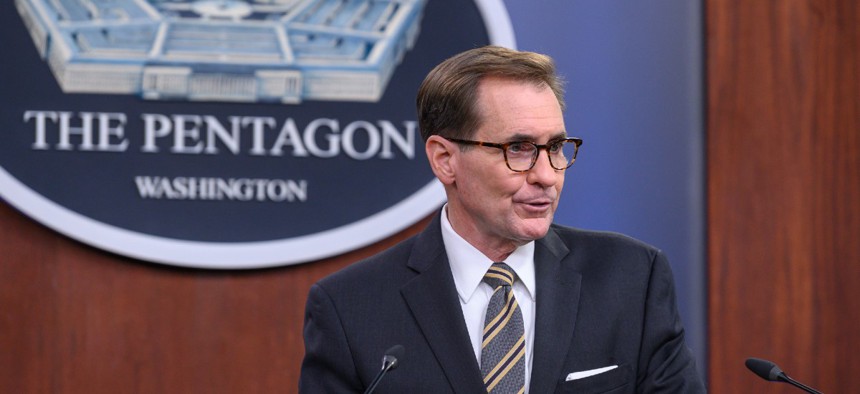Pentagon Removes Thousands of Images of the War in Afghanistan from Website

Pentagon Press Secretary John F. Kirby briefs reporters from the Pentagon Press Briefing Room. Defense Department/Brittany A. Chase
The move, which officials said is temporary, was prompted by concerns that the Taliban would retaliate against Afghans depicted in them, the Defense Department said.
Pentagon Press Secretary John Kirby confirmed that, per his direction, roughly 124,000 photos and 17,000 videos associated with the war in Afghanistan were temporarily taken down from the Defense Media Activity-managed DVIDs website and other publicly accessible platforms.
“We removed thousands of still images and videos that would show the faces or any other identifiable information about many of the Afghans that we've supported and have supported us over the last 20 years,” Kirby told reporters during a briefing on Monday. “It was a mammoth undertaking, and it took us a long time—almost two months.”
The media content was archived and is planned for republication online at a later date, once officials “believe it's the appropriate time to put them back up,” according to the press secretary. Kirby made and acted on this decision quietly around the time the United States military chaotically exited Afghanistan.
At that point, the Defense Department had reason to believe that the Taliban would use publicly available sources like those pictures to target people and their families on the ground who’d helped America in some capacity in the years before.
"The reason why I didn't announce it was because we were in the middle of it. It wouldn't make much sense to tell the world that we were archiving these images before we were done archiving them," Kirby said. "And because it is still an ongoing effort, frankly, this is not the kind of thing that I wanted to have to talk about—because we are still trying to get many of these Afghans out of the country."
He delegated his choice to the Defense Media Activity. In his own words, Kirby’s guidance was, “I want any imagery that could be used to identify individuals and/or family members over the last 20 years of war to be unpublished for a temporary period of time.” Still, portraits of American soldiers and troops in combat there are also reportedly no longer accessible via DVIDs now, which has raised concerns for some former service members.
Though the Pentagon didn’t say whether a mass but temporary takedown of media to protect U.S. allies had ever occurred before, its spokesperson Russell Goemaere told Nextgov on Tuesday that DVIDS periodically receives requests for content to be removed.
“The standard procedure is to send the request to the unit to unpublish the requested content,” he said. “In many instances, requesters identify themselves and ask for content to be unpublished for reasons related to family or individual safety or security.”
Late last week, John Sopko, the special inspector general for Afghan reconstruction, told journalists that the State Department also asked for some reports to be removed from the internet or redacted to help protect the identities of Afghan allies named. At the press briefing, Kirby explained that the Pentagon’s decision to pull its own content was coordinated with the State Department and National Security Council staff, among others.
“We made no secret of the fact that we felt this was the right thing to do,” he said.
NEXT STORY: FCW Insider: November 2, 2021



